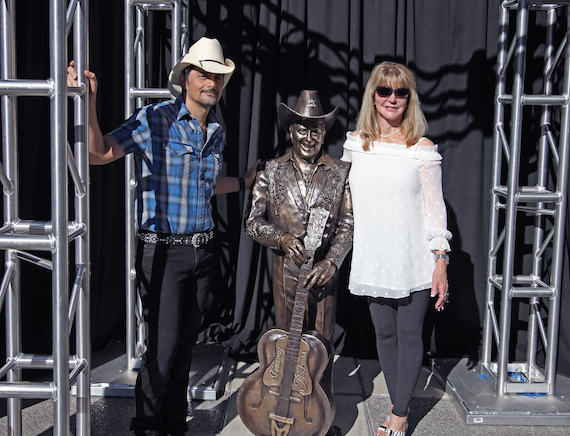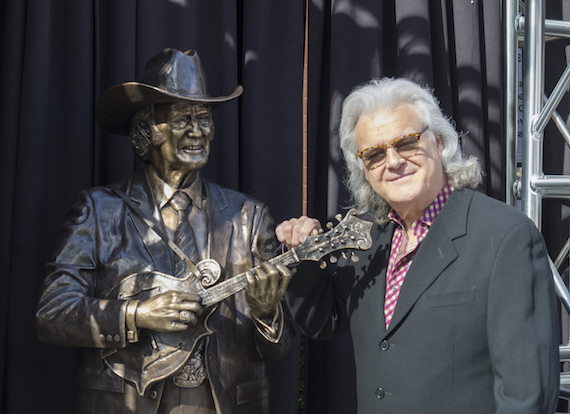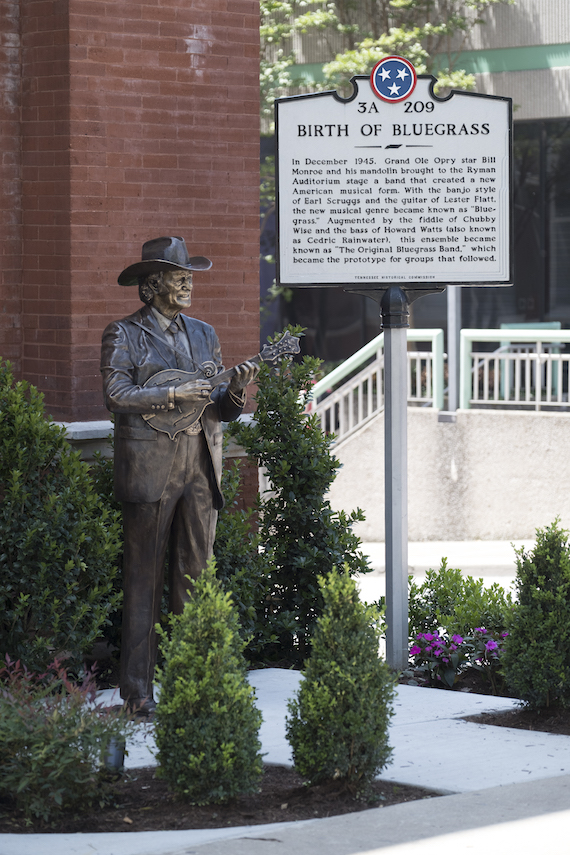

Pictured (L-R): Brad Paisley and Mona Dickens
Photo: Jon-Paul Bruno
Brad Paisley and Ricky Skaggs honored two of country and bluegrass music’s greatest luminaries Wednesday morning (June 7) when Nashville’s Ryman Auditorium unveiled two bronze statues of Jimmy Dickens and Bill Monroe.
The Jimmy Dickens statue sits on the Ryman Plaza, just outside the auditorium’s main entrance. The Monroe statue sits near the corner of Fifth Avenue. Both statues were crafted by Ben Watts.
Bill Cody, of WSM’s Coffee Country and Cody, emceed both unveilings outside the Ryman Auditorium, which celebrates its 125th anniversary this year.
In introducing Dickens’ sculpture, Paisley quipped, “My first question when I heard about this was, ‘Is this life-size, or did they exaggerate it so we can see it? This is a man whose tenure in our format is an amazing achievement in itself, but we can’t forget how important he was to country music as we know it.
“This was a man who was honing his craft before Hank Williams, who we sort of credit as the father of modern country music in many ways,” Paisley continued. “He saw everything in those decades that he stood on that stage, like Patsy Cline and Loretta Lynn and Garth Brooks. By the time Jimmy left us, he had become the Grand Ole Opry. On a night that he wasn’t there, you were cheated out of something and he knew that. He realized when he was well enough to do it, he went. He knew that he owed it to the younger generation that wanted to see him, it was another lesson in how you entertain people. He gave them everything that he had on that stage and in this building for many many years. So I think it’s really appropriate that he’s going to be one of the statues that’s a permanent reminder of what we should be in this building.”
West Virginia native Dickens began his career singing on radio station WOLS in Beckly, West Virginia, while attending University of West Virginia. He was inducted into the Grand Ole Opry in 1948. In 1964, Dickens became the first country artist to completely circle the globe on a world tour. That same year, he released “May The Bird of Paradise Fly Up Your Nose,” which topped the country charts and reached No. 15 on the pop charts.
Dickens was inducted into the Country Music Hall of Fame in 1983. He passed away on Jan. 2, 2015. Before his death, he was the oldest living member of the Grand Ole Opry, and was often seen backstage and onstage, greeting fellow artists and entertaining fans.
Dickens’ wife Mona attended the statue’s unveiling.

Ricky Skaggs . Photo: Terry Wyatt / Getty Images
WSM 650 AM went on air in 1925, when Monroe, who would become the Father of Bluegrass, was 12 years old. Cody recalled Monroe as joking, “WSM, they named that after me. William Smith Monroe.” The WSM was actually named after “We Shield Millions,” the slogan of the National Life and Accident Insurance company, which founded WSM 650 AM.
“I don’t know if you ever get another Bill Monroe in this century,” Skaggs said. “There are not a lot of people that I know that can be cited as creating a whole new genre of music—but he did. He had the ear to hear, the talent to play it, and the heart to keep it alive. He was copied many times but he was the original.”
In the 1920s, Monroe and his brothers Birch and Charlie formed a band and played until the late 1930s. In 1938, he formed the Blue Grass Boys, a group that launched the careers of musicians including Lester Flatt, Earl Scruggs, Mac Wiseman, Stringbean, Sony Osborne and more. Monroe was 28 when he joined the Grand Ole Opry cast in 1939. By the 1940s, he began adding lyrics to the melodies, creating classics including “Uncle Pen” and “Blue Moon of Kentucky.” Monroe was inducted into the Country Music Hall of Fame in 1970.
“I want to tip my hat to WSM 650,” Skaggs said. “50,000 watts blast furnace that blasted this music out in the 1940s because when Earl Scruggs joined Bill Monroe’s band in 1945, Mr. Monroe had Lester Flatt, Chubby Wise and Howard Watts in the band. But when Stringbean left to start his comedy act and solo act, they needed a banjo player and Earl Scruggs, this player who had fire in his right hand, he didn’t create the style but he perfected it. As soon as Mr. Monroe heard that, that I think it all clicked. When that combination came together, it was like the fab five before there was a fab four. They went to Chicago to make those historic recordings for Columbia in 1946, but they weren’t released, until way after Flatt and Scruggs had left the band. So the only way you could hear this music was to listen to the Grand Ole Opry at the Ryman Auditorium. It was here the music was birthed.”
Monroe’s performing career spanned 69 years before he died on Sept. 9, 1996 – just shy of his 85th birthday.

Photo: Steve Lowry/Ryman Archives

Photo: Steve Lowry/Ryman Archives

About the Author
Jessica Nicholson serves as the Managing Editor for MusicRow magazine. Her previous music journalism experience includes work with Country Weekly magazine and Contemporary Christian Music (CCM) magazine. She holds a BBA degree in Music Business and Marketing from Belmont University. She welcomes your feedback at jnicholson@musicrow.com.View Author Profile


